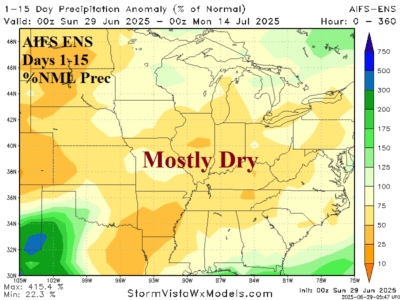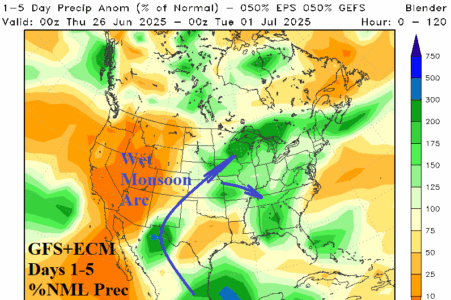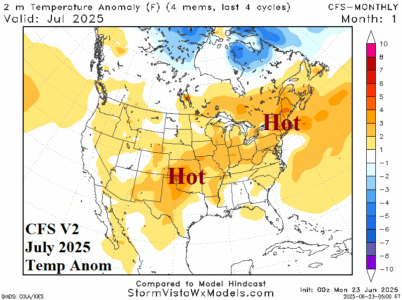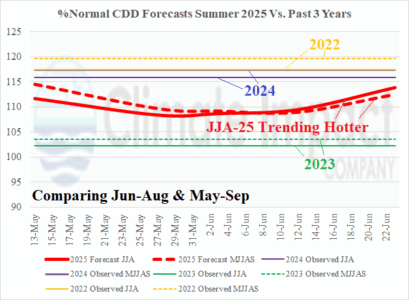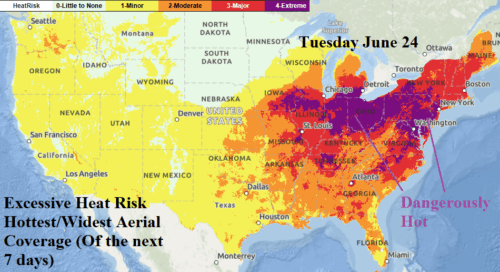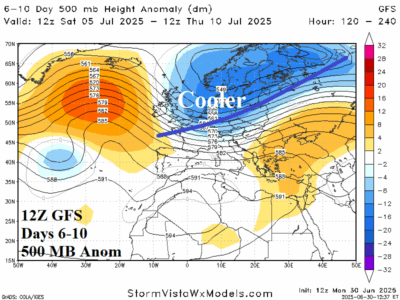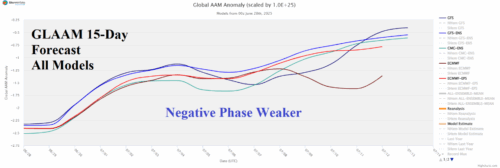Latest News
06/29/2025, 10:12 am EDT
On about July 1st, the AIFS (AI forecast process) becomes the improved and operational AIFS ENS. Up until now, publicly available AI forecast processes skill scores have strongly favored Graph Cast. A look at today's 15-day percent of normal rainfall forecast for the U.S. AG Belt identifies the large disparity between GFS, ECM ENS, and AIFS ENS. Knowing the large-scale climate pattern and recent skill scores are suggested to identify which model to use operationally.
06/26/2025, 5:39 am EDT
An arc of tropical moisture extending across Mexico from the western Gulf of Mexico and northeastward to the Midwest U.S. is (clearly) evident in the 5-day rainfall forecast equally combining GFS and ECM. Outflow boundaries from the Midwest rains trigger thunderstorms across the Southeast U.S. In the 6-10-day period, the Mexico/Southwest U.S. Wet Monsoon intensifies.
06/24/2025, 5:10 am EDT
The CFS V2 month ahead forecast for the U.S. valid July 2025 indicates widespread above normal temperature from the southern Great Plains and Texas to the Northeast U.S. The southern Great Plains and Texas are where the hottest daytime temperature anomalies occur due to the combination of heat and drier than normal mid-summer climate.
06/23/2025, 8:22 am EDT
The Climate Impact Company U.S. selected cities CDD forecast for 2025 is updated. The summertime (JUN/JUL/AUG) CDD outlook adjusts hotter. The national average edges upward to 113.9% of the 30-year normal as the JJA-25 forecast edges close to 2022 and 2024 summertime observations which were 3rd and 4th hottest (respectively) on record.
06/19/2025, 6:36 am EDT
The hottest day in the 7-day NOAA/NWS excessive heat forecast is next Tuesday when the Ohio Valley, including the Chicago area, eastward through the Mid-Atlantic encounters widespread dangerously hot conditions.
Climate Impact Company Chart of the Day
12Z GFS Ends (Temporarily) Europe Heatwave in 6-10 Days
The 12Z GFS indicates a cool/wet upper trough moving into West/North Europe to end the recent heatwave and push the heat toward the Black Sea region (Fig. 1). Unfortunately, Western Europe is likely to turn hot again in the 11-15-day period.
Climate Impact Company Climate Diagnostics
Strong -GLAAM Stalls Weather Patterns, Continues in July
Global atmospheric angular momentum (GLAAM) is currently sharply negative. Negative GLAAM patterns are frequently represented by a slower jet stream, tendency for semi-permanent trough and ridge patterns (caused by the slow down), and responsible for persistent and sometimes harsh weather patterns. The 15-day forecast by all operational models indicates -GLAAM eases but does not end while the CFS V2 6-week forecast carries -GLAAM through July.


